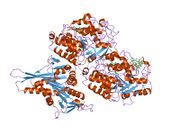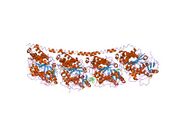Biology:Tubulin beta-4A chain
 Generic protein structure example |
Tubulin beta-4A chain is a protein that in humans is encoded by the TUBB4A gene. Two tubulin beta-4 chain proteins are encoded in the human genome by the genes TUBB4A (this entry) and TUBB4B.[1][2][3] Tubulin is the major constituent of microtubules, a key components of the cytoskeleton. It binds two molecules of GTP, one at an exchangeable site on the beta-chain and one at a non-exchangeable site on the alpha-chain. TUBB4A is preferentially and highly expressed in the central nervous system.[4]
Clinical significance
Mutations in TUBB4A have been associated with two neurological disorders.
An R2G substitution in the autoregulatory MREI domain of TUBB4A has been identified as the cause of 'hereditary whispering dysphonia' or DYT4.[5][6]
A de novo D249N mutation has been identified as the cause of a rare leukoencephalopathy, hypomyelination with atrophy of basal ganglia and cerebellum (H-ABC).[7][8]
Mutations in TUBB4A are associated with Pelizaeus–Merzbacher disease.[9]
References
- ↑ "Identification of two human beta-tubulin isotypes". Molecular and Cellular Biology 3 (5): 854–862. Aug 1983. doi:10.1128/mcb.3.5.854. PMID 6865944.
- ↑ "Sequence of an expressed human beta-tubulin gene containing ten Alu family members". Nucleic Acids Research 12 (14): 5823–5836. Sep 1984. doi:10.1093/nar/12.14.5823. PMID 6462917.
- ↑ "Entrez Gene: TUBB4 tubulin, beta 4". https://www.ncbi.nlm.nih.gov/sites/entrez?Db=gene&Cmd=ShowDetailView&TermToSearch=10382.
- ↑ "UCSC Genome Browser: TUBB4A microarray expression". http://genome.ucsc.edu/cgi-bin/hgGene?hgsid=340488365#microarray.
- ↑ "Mutations in the autoregulatory domain of β-tubulin 4a cause hereditary dystonia". Annals of Neurology 73 (4): 546–553. December 2012. doi:10.1002/ana.23832. PMID 23424103.
- ↑ Online Mendelian Inheritance in Man (OMIM) Dystonia 4, torsion, autosomal dominant; DYT4 -128101
- ↑ "A de novo mutation in the β-tubulin gene TUBB4A results in the leukoencephalopathy hypomyelination with atrophy of the basal ganglia and cerebellum". American Journal of Human Genetics 92 (5): 767–773. May 2013. doi:10.1016/j.ajhg.2013.03.018. PMID 23582646.
- ↑ Online Mendelian Inheritance in Man (OMIM) Leukodystrophy, hypomyelinating, with atrophy of the basal ganglia and cerebellum; HABC -128101
- ↑ Shimojima, K; Okumura, A; Ikeno, M; Nishimura, A; Saito, A; Saitsu, H; Matsumoto, N; Yamamoto, T (2014). "A de novo TUBB4A mutation in a patient with hypomyelination mimicking Pelizaeus-Merzbacher disease". Brain & Development 37 (3): 281–285. doi:10.1016/j.braindev.2014.05.004. PMID 24974158.
Further reading
- "The mammalian beta-tubulin repertoire: hematopoietic expression of a novel, heterologous beta-tubulin isotype.". Journal of Cell Biology 103 (5): 1903–1910. 1987. doi:10.1083/jcb.103.5.1903. PMID 3782288.
- "C-terminal fragments of alpha- and beta-tubulin form amyloid fibrils in vitro and associate with amyloid deposits of familial cerebral amyloid angiopathy, British type.". Biochem. Biophys. Res. Commun. 219 (1): 238–242. 1996. doi:10.1006/bbrc.1996.0211. PMID 8619814.
- "HIV-1 rev depolymerizes microtubules to form stable bilayered rings.". Journal of Cell Biology 150 (2): 349–360. 2000. doi:10.1083/jcb.150.2.349. PMID 10908577.
- "HLA-B2702 (77-83/83-77) peptide binds to beta-tubulin on human NK cells and blocks their cytotoxic capacity.". Journal of Immunology 165 (12): 6776–6782. 2001. doi:10.4049/jimmunol.165.12.6776. PMID 11120798.
- "Generation and initial analysis of more than 15,000 full-length human and mouse cDNA sequences.". Proceedings of the National Academy of Sciences of the United States of America 99 (26): 16899–16903. 2003. doi:10.1073/pnas.242603899. PMID 12477932. Bibcode: 2002PNAS...9916899M.
- "HIV-1 Tat targets microtubules to induce apoptosis, a process promoted by the pro-apoptotic Bcl-2 relative Bim.". EMBO Journal 21 (24): 6801–6810. 2004. doi:10.1093/emboj/cdf683. PMID 12486001.
- "Nuclear coactivator-62 kDa/Ski-interacting protein is a nuclear matrix-associated coactivator that may couple vitamin D receptor-mediated transcription and RNA splicing.". Journal of Biological Chemistry 278 (37): 35325–35336. 2003. doi:10.1074/jbc.M305191200. PMID 12840015.
- "Complete sequencing and characterization of 21,243 full-length human cDNAs.". Nature Genetics 36 (1): 40–45. 2004. doi:10.1038/ng1285. PMID 14702039.
- "A physical and functional map of the human TNF-alpha/NF-kappa B signal transduction pathway.". Nature Cell Biology 6 (2): 97–105. 2004. doi:10.1038/ncb1086. PMID 14743216.
- "The composition of Staufen-containing RNA granules from human cells indicates their role in the regulated transport and translation of messenger RNAs.". Nucleic Acids Research 32 (8): 2411–2420. 2004. doi:10.1093/nar/gkh552. PMID 15121898.
- "Proteins associated with type II bone morphogenetic protein receptor (BMPR-II) and identified by two-dimensional gel electrophoresis and mass spectrometry.". Proteomics 4 (5): 1346–1358. 2004. doi:10.1002/pmic.200300770. PMID 15188402.
- "Proteomic, functional, and domain-based analysis of in vivo 14-3-3 binding proteins involved in cytoskeletal regulation and cellular organization.". Curr. Biol. 14 (16): 1436–1450. 2004. doi:10.1016/j.cub.2004.07.051. PMID 15324660.
- "The glutamine-rich region of the HIV-1 Tat protein is involved in T-cell apoptosis.". Journal of Biological Chemistry 279 (46): 48197–48204. 2005. doi:10.1074/jbc.M406195200. PMID 15331610.
- "The status, quality, and expansion of the NIH full-length cDNA project: the Mammalian Gene Collection (MGC).". Genome Research 14 (10B): 2121–7. 2004. doi:10.1101/gr.2596504. PMID 15489334.
- "HIV-1 Tat protein enhances microtubule polymerization.". Retrovirology 2: 5. 2006. doi:10.1186/1742-4690-2-5. PMID 15691386.
- Giacca M (2006). "HIV-1 Tat, apoptosis and the mitochondria: a tubulin link?". Retrovirology 2: 7. doi:10.1186/1742-4690-2-7. PMID 15698476.
- "Signal sequence and keyword trap in silico for selection of full-length human cDNAs encoding secretion or membrane proteins from oligo-capped cDNA libraries.". DNA Res. 12 (2): 117–126. 2007. doi:10.1093/dnares/12.2.117. PMID 16303743.
- "Modifications in the human T cell proteome induced by intracellular HIV-1 Tat protein expression.". Proteomics 6 Suppl 1: S63–7S3. 2006. doi:10.1002/pmic.200500437. PMID 16526095.
External links
- TUBB4A human gene location in the UCSC Genome Browser.
- TUBB4A human gene details in the UCSC Genome Browser.











